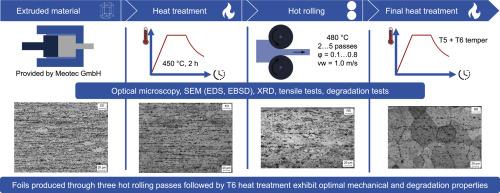Tailoring microstructure and performance of WE43MEO magnesium alloy via multi-pass hot rolling and finishing heat treatment towards foils for biomedical support structures
IF 13.8
1区 材料科学
Q1 METALLURGY & METALLURGICAL ENGINEERING
引用次数: 0
Abstract
WE43MEO magnesium foils (thickness ≤ 200 µm) were successfully produced via hot rolling. The initially extruded material was heat treated at 450 °C for 2 h to achieve a more homogenous microstructure. Afterwards the sheets were hot rolled at 480 °C in two to five rolling passes to achieve a uniform thickness of less than 200 µm and finally heat treated (T5 and T6 heat treatment). After foil rolling and final heat treatment the microstructural und texture evolution as well as resulting mechanical properties were investigated. Therefore, the samples were quenched directly after foil rolling and the final heat treatment. The foil rolling led either to a deformation microstructure (two and three passes) or globular grains (four and five passes) depending on the number of rolling passes. As main recrystallisation mechanisms continuous dynamic recrystallisation (CDRX) and twinning induced dynamic recrystallisation (TDRX) were identified. The resulting textures revealed the activation of non-basal slip of <c + a>-dislocations during prior foil rolling. As a result of the rolling, the strength increased and the elongation decreased compared to the extruded and heat-treated state. Furthermore, it was found that a T6 temper increased corrosion resistance of the tested WE43MEO foils.

通过多道次热轧和精加工热处理对生物医学支撑结构箔的WE43MEO镁合金的组织和性能进行定制
通过热轧成功生产出厚度≤200µm的WE43MEO镁箔。最初挤压的材料在450°C下热处理2小时,以获得更均匀的微观结构。然后在480℃下进行2 ~ 5道次的热轧,使板材厚度均匀,小于200µm,最后进行热处理(T5和T6热处理)。研究了铝箔轧制和终热处理后的组织、织构演变及其力学性能。因此,试样在箔轧制和最终热处理后直接淬火。根据轧制道次的不同,箔的轧制可导致变形组织(两道次和三道次)或球状晶粒(四道次和五道次)。确定了连续动态再结晶(CDRX)和孪生诱导动态再结晶(TDRX)为主要的再结晶机制。所得到的织构揭示了先前箔轧制过程中<;c + >;-位错的非基底滑移的激活。与挤压和热处理状态相比,轧制的结果是强度提高,伸长率降低。此外,还发现T6回火提高了WE43MEO箔的耐腐蚀性。
本文章由计算机程序翻译,如有差异,请以英文原文为准。
求助全文
约1分钟内获得全文
求助全文
来源期刊

Journal of Magnesium and Alloys
Engineering-Mechanics of Materials
CiteScore
20.20
自引率
14.80%
发文量
52
审稿时长
59 days
期刊介绍:
The Journal of Magnesium and Alloys serves as a global platform for both theoretical and experimental studies in magnesium science and engineering. It welcomes submissions investigating various scientific and engineering factors impacting the metallurgy, processing, microstructure, properties, and applications of magnesium and alloys. The journal covers all aspects of magnesium and alloy research, including raw materials, alloy casting, extrusion and deformation, corrosion and surface treatment, joining and machining, simulation and modeling, microstructure evolution and mechanical properties, new alloy development, magnesium-based composites, bio-materials and energy materials, applications, and recycling.
 求助内容:
求助内容: 应助结果提醒方式:
应助结果提醒方式:


